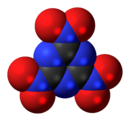Trinitrotriazin
Appearance
| |||
| Nazivi | |||
|---|---|---|---|
| Preferisani IUPAC naziv
2,4,6-Trinitro-1,3,5-triazine | |||
| Identifikacija | |||
3D model (Jmol)
|
|||
| ChemSpider | |||
| |||
| Svojstva | |||
| C3N6O6 | |||
| Molarna masa | 216,07 g·mol−1 | ||
Ukoliko nije drugačije napomenuto, podaci se odnose na standardno stanje materijala (na 25 °C [77 °F], 100 kPa). | |||
| Reference infokutije | |||
Trinitrotriazin, ili 2,4,6-trinitro-1,3,5-triazin, je teoretsko eksplozivno jedinjenje, sa ormulom C
3N
6O
6, koje sadrži 3 atoma ugljenika i ima molekulsku masu od 216,069 Da. Sinteza ovog jedinjenja je bila neuhvatljiva uprkos njegovoj jednostavnoj strukturi, [3][4] jer konvencionalna nitracija triazina postaje sve teža kako se dodaje više nitro grupa. Uspešan put bi verovatnije tekao trimerizacijom nitril cijanida. [5] Prekursor nitril cijanid je prvi put sintetisao Rahm i saradnici 2014. godine. [6]
Trinitrotriazin ima neutralnu kiseoničku ravnotežu, što ga potencijalno čini veoma moćnim eksplozivom, iako proračuni predviđaju da bi bio prilično nestabilan i inferioran u odnosu na srodno jedinjenje 3,6-dinitro-1,2,4,5-tetrazin. [7]
Osobine
[uredi | uredi izvor]| Osobina | Vrednost |
|---|---|
| Broj akceptora vodonika | 9 |
| Broj donora vodonika | 0 |
| Broj rotacionih veza | 3 |
| Particioni koeficijent[8] (ALogP) | 1,2 |
| Rastvorljivost[9] (logS, log(mol/L)) | -4,0 |
| Polarna površina[10] (PSA, Å2) | 176,1 |
Vidi još
[uredi | uredi izvor]- RDX (heksahidro-1,3,5-trinitro-1,3,5-triazin)
Reference
[uredi | uredi izvor]- ^ Li Q, Cheng T, Wang Y, Bryant SH (2010). „PubChem as a public resource for drug discovery.”. Drug Discov Today. 15 (23-24): 1052—7. PMID 20970519. doi:10.1016/j.drudis.2010.10.003.
- ^ Evan E. Bolton; Yanli Wang; Paul A. Thiessen; Stephen H. Bryant (2008). „Chapter 12 PubChem: Integrated Platform of Small Molecules and Biological Activities”. Annual Reports in Computational Chemistry. 4: 217—241. doi:10.1016/S1574-1400(08)00012-1.
- ^ G. D. Hartman, R. D. Hartman and J. E. Schwering. Tetrahedron Letters. 1983; 24: 1011.
- ^ M. D. Coburn, C. L. Coon, H. H. Hayden and A. R. Mitchell. Synthesis. 1986: 490.
- ^ Korkin AA. Bartlett RJ. Theoretical Prediction of 2,4,6-Trinitro-1,3,5-triazine (TNTA). A New, Powerful, High-Energy Density Material? Journal of the American Chemical Society. 1996; 118: 12244-12245.
- ^ Rahm, M., Bélanger-Chabot, G., Haiges, R. and Christe, K. O. (2014), Nitryl Cyanide, NCNO2. Angew. Chem. Int. Ed., 53: 6893–6897
- ^ Jinshan Li. An Ab Initio Theoretical Study of 2,4,6-Trinitro-1,3,5-Triazine, 3,6-Dinitro-1,2,4,5-Tetrazine, and 2,5,8-Trinitro-Tri-s-Triazine, more commonly known as RDX. Propellants, Explosives, Pyrotechnics. December 2008; 33(6):443-447.
- ^ Ghose, A.K.; Viswanadhan V.N. & Wendoloski, J.J. (1998). „Prediction of Hydrophobic (Lipophilic) Properties of Small Organic Molecules Using Fragment Methods: An Analysis of AlogP and CLogP Methods”. J. Phys. Chem. A. 102: 3762—3772. doi:10.1021/jp980230o.
- ^ Tetko IV, Tanchuk VY, Kasheva TN, Villa AE (2001). „Estimation of Aqueous Solubility of Chemical Compounds Using E-State Indices”. Chem Inf. Comput. Sci. 41: 1488—1493. PMID 11749573. doi:10.1021/ci000392t.
- ^ Ertl P.; Rohde B.; Selzer P. (2000). „Fast calculation of molecular polar surface area as a sum of fragment based contributions and its application to the prediction of drug transport properties”. J. Med. Chem. 43: 3714—3717. PMID 11020286. doi:10.1021/jm000942e.
Literatura
[uredi | uredi izvor]- Clayden, Jonathan; Greeves, Nick; Warren, Stuart; Wothers, Peter (2001). Organic Chemistry (I изд.). Oxford University Press. ISBN 978-0-19-850346-0.
- Smith, Michael B.; March, Jerry (2007). Advanced Organic Chemistry: Reactions, Mechanisms, and Structure (6th изд.). New York: Wiley-Interscience. ISBN 0-471-72091-7.
- Katritzky A.R.; Pozharskii A.F. (2000). Handbook of Heterocyclic Chemistry (Second изд.). Academic Press. ISBN 0080429882.


